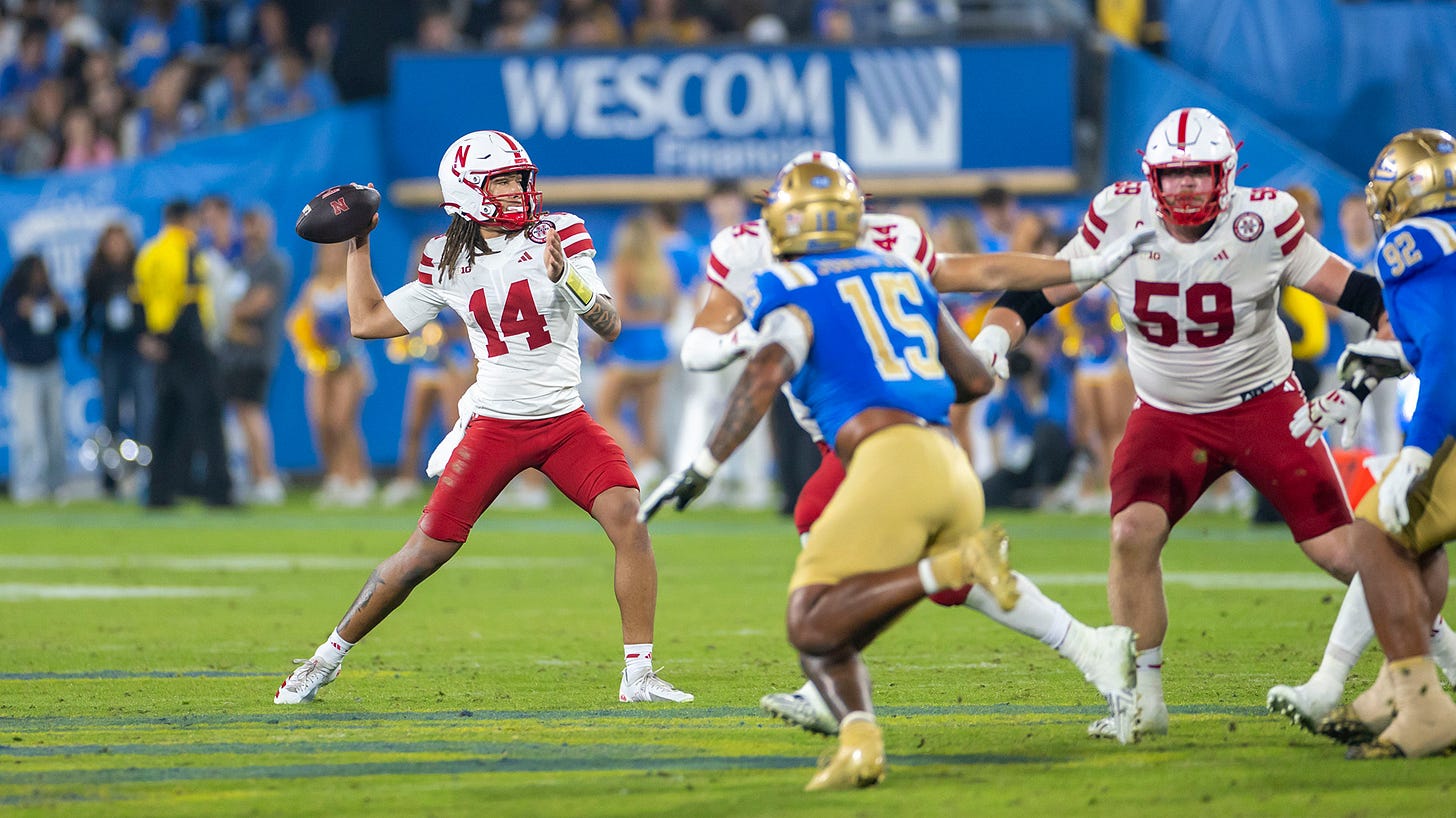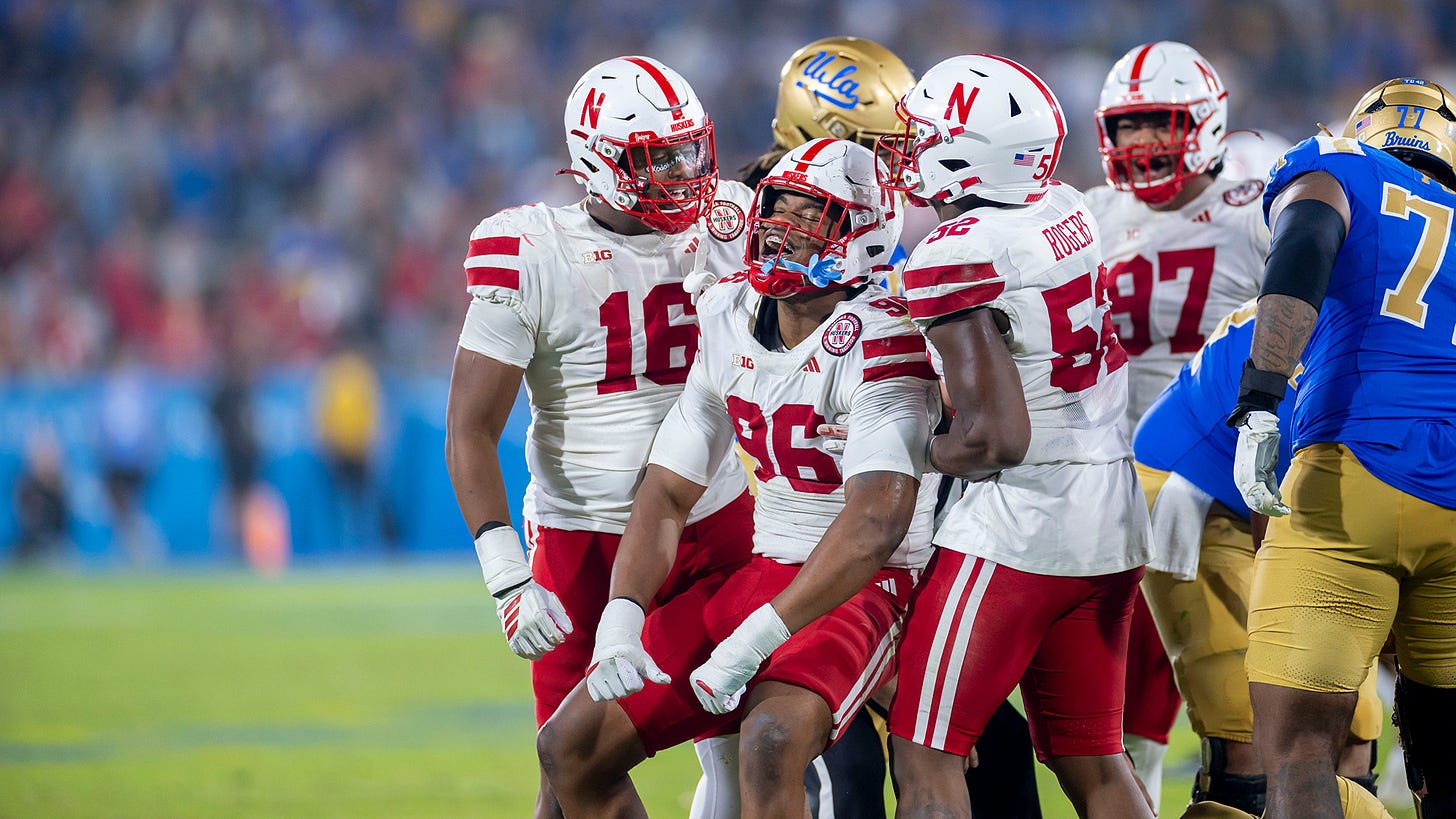A win that ranks among the best of the Rhule era
Reviewing Nebraska-UCLA plus an uncomfortable question in the afterglow: "Should NU be better?"
Prior to the start of the Matt Rhule era, Nebraska had lost six straight games when starting its backup quarterback. You had to go back to a Ryker Fyfe-led 28-7 win over Maryland1 late in 2016 to find the last time the Huskers had won with a Plan B.
Rhule had to confront that streak in just his third game, a 35-11 win over Northern Illinois in which Heinrich Haarberg threw two touchdowns, ran for another and led the Huskers in rushing. Haarberg would go 5-22 as the starter before getting injured early in the Maryland game in 2023.
Saturday night’s 28-21 win over UCLA, behind TJ Lateef’s 13-of-15, three-TD night in his first start, represented Nebraska’s sixth win while starting the backup QB under Rhule. To put it another way, nearly a third of Rhule’s 19 wins in Lincoln have come with the guy judged to be not quite as good as the other guy.
That says something about what the Huskers have built since 2023. The “What’s Next?” philosophy is by now a familiar part of the program, but games like Saturday’s continue to show it’s not an empty slogan.
I’d rank it right up there with the best top-to-bottom wins NU’s had under Rhule, maybe trailing only last year’s victory over Colorado.
The plan and play-calling kept things comfortable for Lateef all night. The wide receivers and o-line blocked well in the run game. It was the night Emmett Johnson (232 total yards from scrimmage, 3 TDs) went from “maybe he’s first-team All-Big Ten” to “maybe he’s an All-American.”
At first glance, the defensive numbers might look a little off the usual pace of what we’ve seen this season, but the plan made sense here, too. Nebraska’s going to give up some rushing yards—you know it and it knows it at this point. In the two November games so far, we’ve seen the Huskers find a way to succeed within that reality. The first Bruins touchdown of the night required a 17-play drive and the final one required a 98-yard march to cut it to one score. The Blackshirts were on the field for those drives, sure, but they’re the sort of drives that happen so infrequently that you just have to tip your cap3 and think, “bet you can’t do it again.” Most offenses won’t if 17 plays or 98 yards is the ask.
That defensive approach served the Huskers well against the California teams, but it’ll get a test over the final two games after a bye week. Penn State, losers of six straight, still has two of the best running backs in the conference and Iowa’s still Iowa but with the added element of Mark Gronowski, a run threat who has more than twice as many touchdowns on the ground (12) than through the air (5).
Husker fans can worry about those things in a week. For now, they can revel in a great example of a “program win” on the road. Lateef was so good, and so was most everything else around him, that it opens everything back up for the remainder of 2025.
Can’t ask for much more from a late4 night in LA
.
How’s the equation holding up?
Given the Huskers are on a bye, I wanted to use the time to revisit something from the offseason. All the way back in March I wrote about what I thought “the equation” might be for Nebraska in 2025:
[offense gets about 12 points per game better, to approach 35] + [defense gets no more than 5 points per game allowed worse] + [any improvement on special teams, where being a net neutral would represent a massive improvement] = flirting with nine wins.
How is Nebraska holding up against those measures? The offense is currently at 32.5 points per game and is clearly better than it was a year ago. With a trip to Penn State and Iowa on Black Friday in Lincoln still on the schedule, I’m guessing the Huskers finish the regular season averaging around 31 points per game. That’s a little short of what I was penciling out eight months ago.
However, the defense under John Butler hasn’t really dropped off at all from what Tony White coordinated last year. Nebraska allowed 19.5 points per game in 2024 and is allowing 19.9 in 2025. I doubt that number moves much over the next two games, but let’s call it 21 points per game at the end of the regular season. That would still get NU to the 10 points-per-game differential it probably needed to “flirt with nine wins.”
But special teams has completely blown past “being a net neutral.” The FEI model currently ranks Nebraska’s special teams sixth in overall efficiency, and you can clearly point to huge special teams plays being instrumental in the wins over Michigan State, Maryland and Northwestern.
It prompts a somewhat uncomfortable question while still in the glow of a road conference win with the backup QB—should Nebraska be better? Depends, I suppose, on if the equation was ever accurate to begin with, but as it stands now the offense is about a field goal off of where I thought it needed to be, the defense is about a field goal better than I thought it would be and special teams is way better than seemed reasonable.
Are the Huskers “nine-wins good” right now, regardless of what the record ends up? Right now, I’d say, “yeah.”5 In that context, the Minnesota game continues to stand out in stark relief as the one game Nebraska didn’t look like its 2025 self. Finding a way in a 3-point loss to Michigan or 4-point loss to USC, both home games, would also change the calculation and perception here.
None of those things can be changed, and there’s still a coin-flip’s chance the Huskers actually get to nine wins this season. If they split the two remaining games, it might be fair to feel a twinge of “what might’ve been,” but I’d have a hard time taking much issue with what Nebraska did over 12 games.
Lose out, however, and this is probably a topic we revisit in the offseason.
NU was a two-touchdown favorite that day, so Fyfe had some margin for error.
Nebraska was favored in four of those games.
Doff of the cap and a bow to UCLA QB Nico Iamaleava, who was the reason his team had a chance in that game.
Though I guess in LA it wasn’t that late, but you get what I mean.
That’s not completely opinion, either. Outscore opponents by 10 points per game on the year, and you should be in the neighborhood of nine wins.






The Akron and Houston Christian games sort of distort the stats. But as you suggest, the last two games will help answer that question.